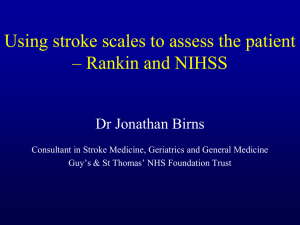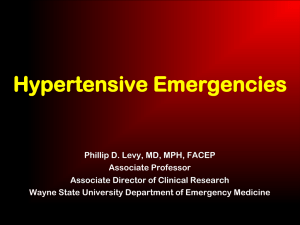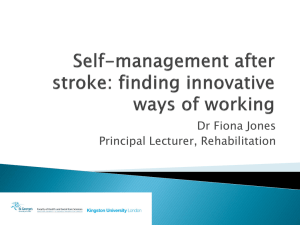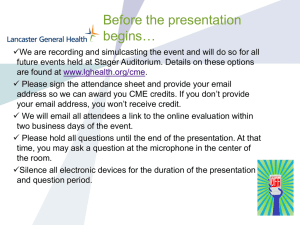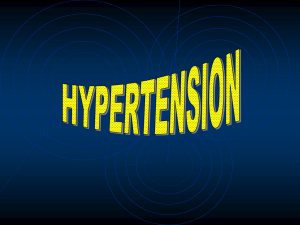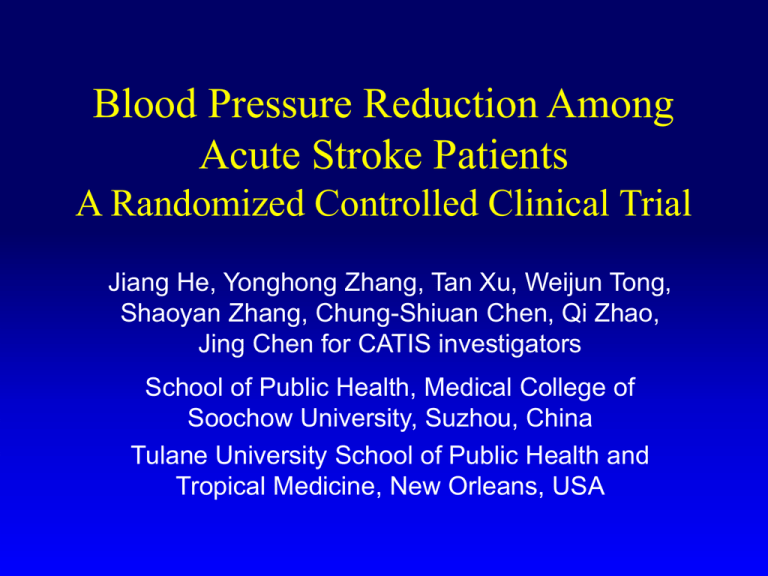
Blood Pressure Reduction Among
Acute Stroke Patients
A Randomized Controlled Clinical Trial
Jiang He, Yonghong Zhang, Tan Xu, Weijun Tong,
Shaoyan Zhang, Chung-Shiuan Chen, Qi Zhao,
Jing Chen for CATIS investigators
School of Public Health, Medical College of
Soochow University, Suzhou, China
Tulane University School of Public Health and
Tropical Medicine, New Orleans, USA
Background
• Stroke is the second leading cause of death and
the leading cause of serious, long-term disability
worldwide.
• Clinical trials have documented that lowering BP
reduces the risk of stroke in hypertensives and
normotensives with a history of stroke or
transient ischemic attack.
• The effect of immediate antihypertensive
treatment in acute ischemic stroke patients with
elevated BP is uncertain.
Objectives
• The primary objective is to test whether an
immediate BP reduction within the first 48 hours
after the onset of an acute ischemic stroke
would reduce death and major disability at 14
days or hospital discharge.
• The secondary objective is to test the effects of
antihypertensive treatment during the acute
phase of ischemic stroke on mortality, major
disability, and vascular events at 3 months.
Study Participants
• China Antihypertensive Trial in Acute Ischemic
Stroke (CATIS) was a multicenter, randomized,
single-blind, blinded end-points trial.
• 4,071 patients aged ≥22 years who had
ischemic stroke, confirmed by brain CT or MRI,
within 48 hours of symptom onset and who had
an elevated systolic BP between 140 and <220
mm Hg were included.
• Patients were recruited from 26 hospitals across
China between August 2009 and May 2013.
Exclusion Criteria
• Severe heart failure (NYHA class III and IV), acute
myocardial infarction, unstable angina, atrial
fibrillation, aortic dissection, and severe
cerebrovascular stenosis
• Patients in a deep coma
• Blood pressure ≥220/120 mm Hg
• Resistant hypertension
• Intravenous thrombolytic therapy
• Current pregnant women
• Unable to participate in the follow-up examination
Study Participant Flow Diagram
22,230 patients assessed for eligibility
4,071 randomized
2,038 randomized to
antihypertensive treatment
2,033 randomized to control
2,038 included in analysis at
14 days or hospital discharge
2,033 included in analysis at
14 days or hospital discharge
50 lost to follow-up
46 lost to follow-up
1,988 included in analysis at
3 months
1,987 included in analysis at
3 months
Intervention
• Antihypertensive treatment
– Lowering systolic BP by 10-25% within the
first 24 hours after randomization
– Achieving a systolic BP <140 and diastolic BP
<90 mm Hg within 7 days, and maintaining
this level of BP control during the remainder of
a patient’s hospitalization
• Control
– Discontinuing all home antihypertensive
medications
Baseline Characteristics of Participants
Characteristics
Age, years
Male, %
Time from onset, hours
Systolic BP at entry, mm Hg
Median NIHSS Score
Hypertension, %
Use of BP medications, %
Subtypes, %
Thrombotic
Embolic
Lacunar
Treatment
62.1
64.6
15.3
166.7
4.0
79.0
49.8
Control
61.8
63.3
14.9
165.6
4.0
78.7
48.4
77.3
4.9
20.5
78.5
5.1
18.9
Systolic BP Since Randomization by
Treatment Group
Systolic BP Reduction During Hospitalization
Treatment
Control
∆ (95% CI)
P value
Absolute changes within 24 hrs, mm Hg
-21.8
-12.7
-9.1 (-10.2, -8.1)
<0.001
Proportional changes within 24 hrs, %
-12.7
-7.2
-5.5 (-4.9, -6.1)
<0.001
Systolic BP at day 7 after randomization, mm Hg
137.3
146.5
-9.3 (-10.1, -8.4)
<0.001
Systolic BP at day 14 after randomization, mm Hg
135.2
143.7
-8.6 (-9.7, -7.4)
<0.001
Primary and Secondary Outcomes at 14 Days
or Hospital Discharge
Control
Odds Ratio
P
(95% CI) value
33.6
33.6
1.00
0.98
(0.88, 1.14)
2.0
2.0
0.70
Treatment
Death or major
disability, %
Median
modified Rankin
score
Death, %
1.2
1.2
1.00
0.99
(0.57, 1.74)
Median time of
hospitalization,
days
13.0
13.0
0.28
Secondary Outcomes at the 3-Month
Post-treatment Follow-up Visit
Treatment Control
Death or major
disability, %
Median modified
Rankin score
Death, %
Recurrent stroke,
%
Vascular events,
%
Death or vascular
events, %
25.2
25.3
1.0
1.0
3.4
2.7
1.4
2.2
2.4
3.0
4.6
4.7
Odds Ratio
P
(95% CI) value
0.99
0.93
(0.86, 1.15)
0.52
1.27
(0.88, 1.82)
0.65
(0.40, 1.04)
0.81
(0.55, 1.19)
0.98
(0.73, 1.31)
0.20
0.07
0.28
0.88
Antihypertensive Treatment Effect on Death or Major Disability
at 14 Days According to Prespecified Subgroups
Age, years
<65
≥65
1.12 (0.94, 1.34)
0.054
0.87 (0.71, 1.05)
Sex
Women
Men
1.05 (0.85, 1.30)
0.98 (0.83, 1.15)
0.61
0.96 (0.80, 1.14)
1.15 (0.84, 1.57)
1.04 (0.81, 1.34)
0.59
Time from onset, <12
12-23
hours
≥24
Baseline SBP,
mm Hg
<160
160-179
≥180
1.08 (0.87, 1.35)
0.98 (0.80, 1.19)
0.90 (0.69, 1.19)
0.59
History of
hypertension
No
Yes
1.00 (0.75, 1.32)
1.00 (0.87, 1.16)
0.97
Antihypertensive No
medications
Yes
0.95 (0.79, 1.13)
1.07 (0.88, 1.29)
0.36
1.14 (0.87, 1.49)
1.04 (0.86, 1.25)
0.67 (0.18, 2.44)
0.66
NIHSS
0-4
5-15
≥16
Antihypertensive Treatment Effect on Death or Major Disability
at 3 Months According to Prespecified Subgroups
Age, years
<65
≥65
1.02 (0.83, 1.25)
0.96 (0.78, 1.18)
0.72
Sex
Women
Men
1.07 (0.85, 1.35)
0.95 (0.79, 1.14)
0.43
1.10 (0.91, 1.34)
1.22 (0.85, 1.74)
0.73 (0.55, 0.97)
0.03
Time from onset, <12
12-23
hours
≥24
Baseline SBP,
mm Hg
<160
160-179
≥180
1.04 (0.81, 1.33)
1.07 (0.86, 1.33)
0.79 (0.59, 1.06)
0.24
History of
hypertension
No
Yes
1.06 (0.77, 1.44)
0.98 (0.83, 1.15)
0.67
Antihypertensive No
medications
Yes
0.95 (0.78, 1.16)
1.04 (0.85, 1.28)
0.53
0.83 (0.61, 1.12)
1.19 (0.98, 1.44)
0.66 (0.28, 1.58)
0.08
NIHSS
0-4
5-15
≥16
Limitations
• Patients treated with intravenous thrombolytic
therapy (i.e., intravenous rtPA) at baseline were
excluded from this trial.
• Patients included in this trial had a lower median
NIHSS of 4 (interquartile range 2-8) compared
with 7 (2-10) in Chinese national registry data.
• This trial was conducted exclusively in Chinese
patients.
Conclusion
• Among patients with acute ischemic stroke, BP
reduction with antihypertensive medications
compared with the absence of antihypertensive
medications did not reduce death and major
disability at 14 days or hospital discharge.
• These findings suggest that unless a patient’s
BP ≥220/120 mmHg, the decision to lower BP
with antihypertensive treatment in patients with
acute ischemic stroke should be based on
individual clinical judgment.
J He and coauthors for the CATIS
Investigators
Effects of Immediate Blood Pressure
Reduction on Death and Major Disability in
Patients With Acute Ischemic Stroke: The
CATIS Randomized Clinical Trial
Published online November 17, 2013
Available at jama.com and
mobile.jamanetwork.com
jamanetwork.com
Acknowledgements
• This study is supported by Tulane University and the
Collins C. Diboll Private Foundation, both in New
Orleans, LA; Soochow University, a Project of the Priority
Academic Program Development of Jiangsu Higher
Education Institutions, and the National Natural Science
Foundation of China (grant No. 81320108026), all in
China.
• We acknowledge that the Changzhou Pharmaceutical
Factory provided the study drug (Enalapril) for this trial.
• We thank the study participants and their relatives and
the clinical staff at all participating hospitals for their
support and contribution to this project.




